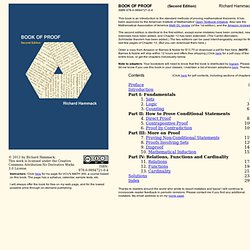

Opposite Day. "Today is opposite day," said the Bully, "yes means no and no means yes.

Now, do you want me to hit you? " Clyde scratched his head. He could see that this was going to be a very delicate negotiation, but he was fairly sure that he would be able to maneuver his way out of it. "That statement is inherently contradictory," Clyde said, adjusting his glasses, "as I’m sure you are aware. If today is, in fact, opposite day, then your statement to that effect would be false, and today would, consequently, not be opposite day at all. "It’s an interesting point you make, Clyde," said the Bully, "but, unfortunately, not applicable. Clyde was impressed. "Again, there’s an error in your logic, Clyde. " Clyde adjusted his glasses. "I think I said it the other way around, but go on. " "Well, that statement then becomes the contradiction.
"I see where you’re going with this, but I’m afraid you’re in error. How to Disagree. March 2008 The web is turning writing into a conversation.

Twenty years ago, writers wrote and readers read. The web lets readers respond, and increasingly they do—in comment threads, on forums, and in their own blog posts. Many who respond to something disagree with it. That's to be expected. The result is there's a lot more disagreeing going on, especially measured by the word. If we're all going to be disagreeing more, we should be careful to do it well. DH0. This is the lowest form of disagreement, and probably also the most common. U r a fag!!!!!!!!!! But it's important to realize that more articulate name-calling has just as little weight. The author is a self-important dilettante. is really nothing more than a pretentious version of "u r a fag. " DH1. An ad hominem attack is not quite as weak as mere name-calling. Of course he would say that. This wouldn't refute the author's argument, but it may at least be relevant to the case. SCHOPENHAUER'S 38 STRATAGEMS, OR 38 WAYS TO WIN AN ARGUMENT.
Arthur Schopenhauer (1788-1860), was a brilliant German philosopher.

These 38 Stratagems are excerpts from "The Art of Controversy", first translated into English and published in 1896. Carry your opponent's proposition beyond its natural limits; exaggerate it. The more general your opponent's statement becomes, the more objections you can find against it. The more restricted and narrow his or her propositions remain, the easier they are to defend by him or her. Use different meanings of your opponent's words to refute his or her argument. (abstracted from the book:Numerical Lists You Never Knew or Once Knew and Probably Forget, by: John Boswell and Dan Starer) Logical Fallacies and How to Spot Them. Logical Fallacies and How to Spot Them In the Evolution vs.

Creationism debate, it is important to be able to spot all the logical fallacies that Creationists tend to throw around. This essay covers many bare essentials of logical thinking, as well as ways to critically evaluate an argument. The logical fallacies listed here are the ones most often used by Creationists, although Creationists have, to date, used almost every single logical fallacy in existence to "prove" their case.
Each fallacy will have its own little paragraph, describing it, why it is fallacious and how to counter it. THE STRAWMAN ATTACK: The strawman is, perhaps, the most heavily-employed tactic used by Creationists. "Evolution is a ridiculous theory! This is an example of a strawman attack. Spotting a strawman attack isn't that hard. Strawman attacks, once exposed for what they are, are not all that difficult to counter. THE FALSE DILEMMA FALLACY: The false dilemma is at the heart of the Creationist argument. Hammack Home. This book is an introduction to the standard methods of proving mathematical theorems.

It has been approved by the American Institute of Mathematics' Open Textbook Initiative. Also see the Mathematical Association of America Math DL review (of the 1st edition), and the Amazon reviews. The second edition is identical to the first edition, except some mistakes have been corrected, new exercises have been added, and Chapter 13 has been extended.
(The Cantor-Bernstein-Schröeder theorem has been added.) The two editions can be used interchangeably, except for the last few pages of Chapter 13. Order a copy from Amazon or Barnes & Noble for $13.75 or download a pdf for free here. Part I: Fundamentals Part II: How to Prove Conditional Statements Part III: More on Proof Part IV: Relations, Functions and Cardinality Thanks to readers around the world who wrote to report mistakes and typos! Instructors: Click here for my page for VCU's MATH 300, a course based on this book.